Analysis of the Endocrine System: Hormone Interactions and Regulation
VerifiedAdded on 2020/10/04
|12
|2555
|58
Report
AI Summary
This report provides a comprehensive analysis of the endocrine system. It begins with a simulation of hormone release, detailing the control mechanisms and principal actions of various hormones like insulin, norepinephrine, thyroxine, and reproductive hormones. The report then explores the differences in cellular interaction mechanisms between cortisol and insulin, highlighting their solubility and receptor binding processes. Further sections delve into the workings of the anterior lobe of the pituitary gland and its connection to the hypothalamus, including feedback mechanisms. The role of the posterior pituitary gland and its link to the nervous system are also discussed. The report then examines the adrenal gland, its functions in homeostasis, and the circumstances leading to adrenaline secretion, along with the impact of adrenal gland hormones. Finally, it includes an analysis of glucose levels in urine, graphical analysis of the relationship between glucose and insulin, and the role of glucagon in controlling blood glucose levels.
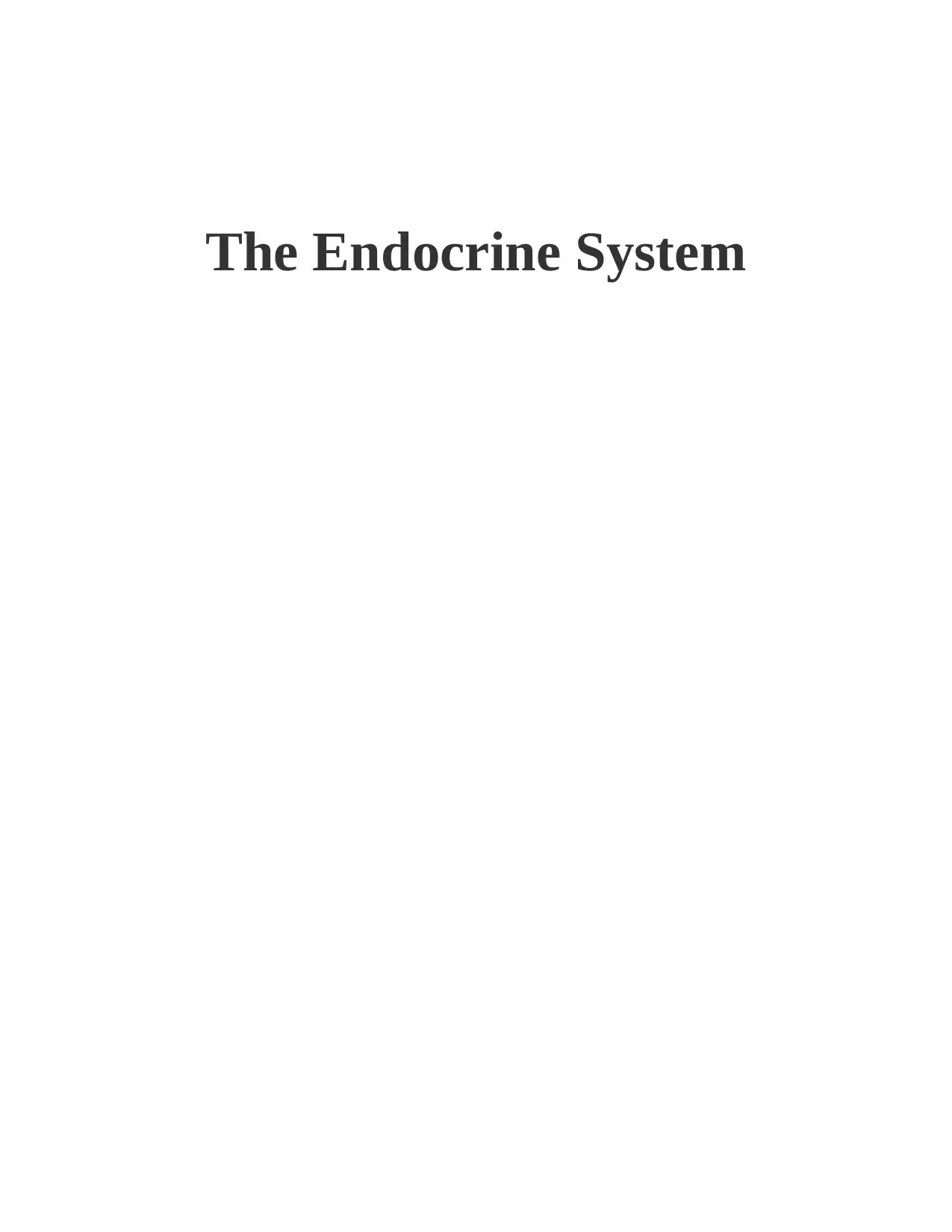
The Endocrine System
Paraphrase This Document
Need a fresh take? Get an instant paraphrase of this document with our AI Paraphraser
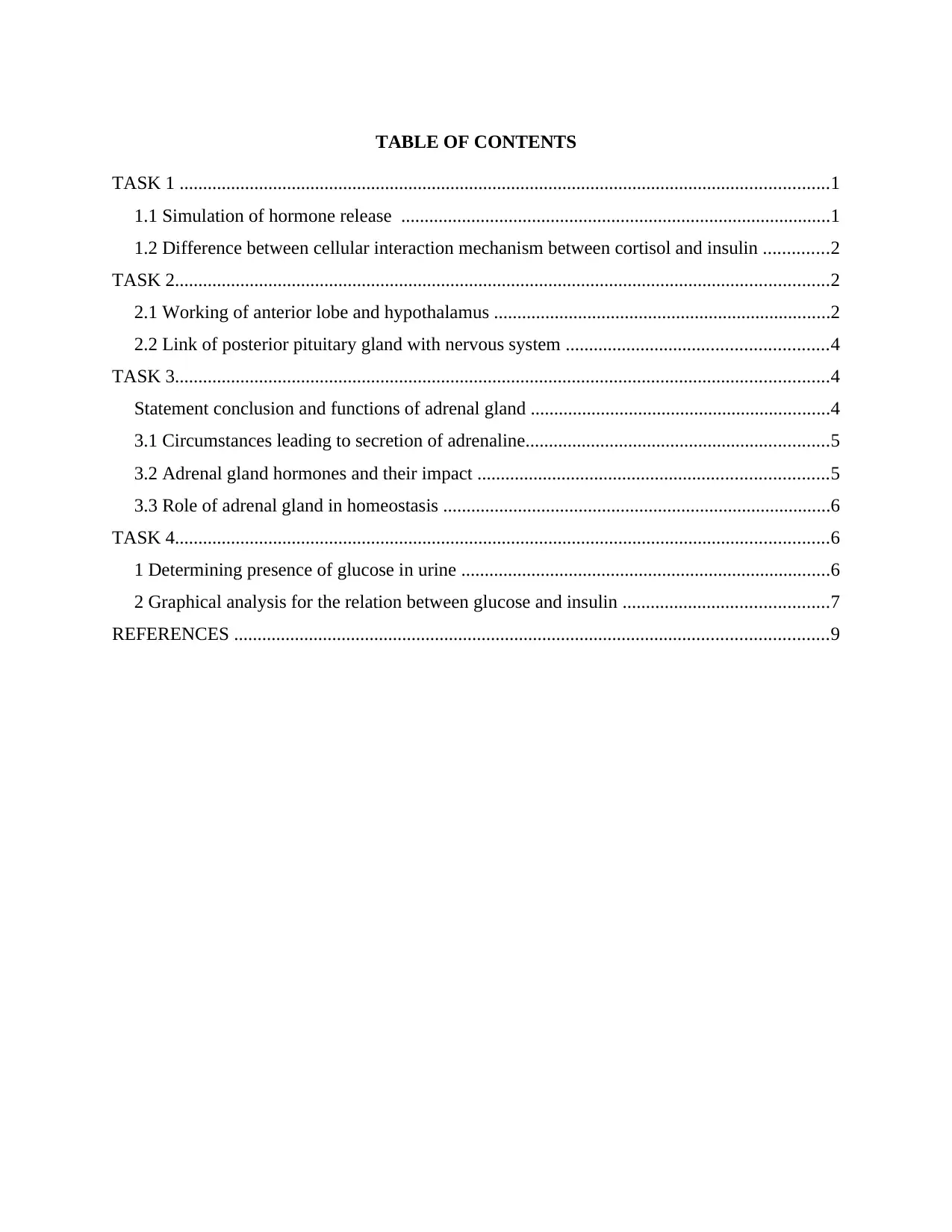
TABLE OF CONTENTS
TASK 1 ...........................................................................................................................................1
1.1 Simulation of hormone release ............................................................................................1
1.2 Difference between cellular interaction mechanism between cortisol and insulin ..............2
TASK 2............................................................................................................................................2
2.1 Working of anterior lobe and hypothalamus ........................................................................2
2.2 Link of posterior pituitary gland with nervous system ........................................................4
TASK 3............................................................................................................................................4
Statement conclusion and functions of adrenal gland ................................................................4
3.1 Circumstances leading to secretion of adrenaline.................................................................5
3.2 Adrenal gland hormones and their impact ...........................................................................5
3.3 Role of adrenal gland in homeostasis ...................................................................................6
TASK 4............................................................................................................................................6
1 Determining presence of glucose in urine ...............................................................................6
2 Graphical analysis for the relation between glucose and insulin ............................................7
REFERENCES ...............................................................................................................................9
TASK 1 ...........................................................................................................................................1
1.1 Simulation of hormone release ............................................................................................1
1.2 Difference between cellular interaction mechanism between cortisol and insulin ..............2
TASK 2............................................................................................................................................2
2.1 Working of anterior lobe and hypothalamus ........................................................................2
2.2 Link of posterior pituitary gland with nervous system ........................................................4
TASK 3............................................................................................................................................4
Statement conclusion and functions of adrenal gland ................................................................4
3.1 Circumstances leading to secretion of adrenaline.................................................................5
3.2 Adrenal gland hormones and their impact ...........................................................................5
3.3 Role of adrenal gland in homeostasis ...................................................................................6
TASK 4............................................................................................................................................6
1 Determining presence of glucose in urine ...............................................................................6
2 Graphical analysis for the relation between glucose and insulin ............................................7
REFERENCES ...............................................................................................................................9
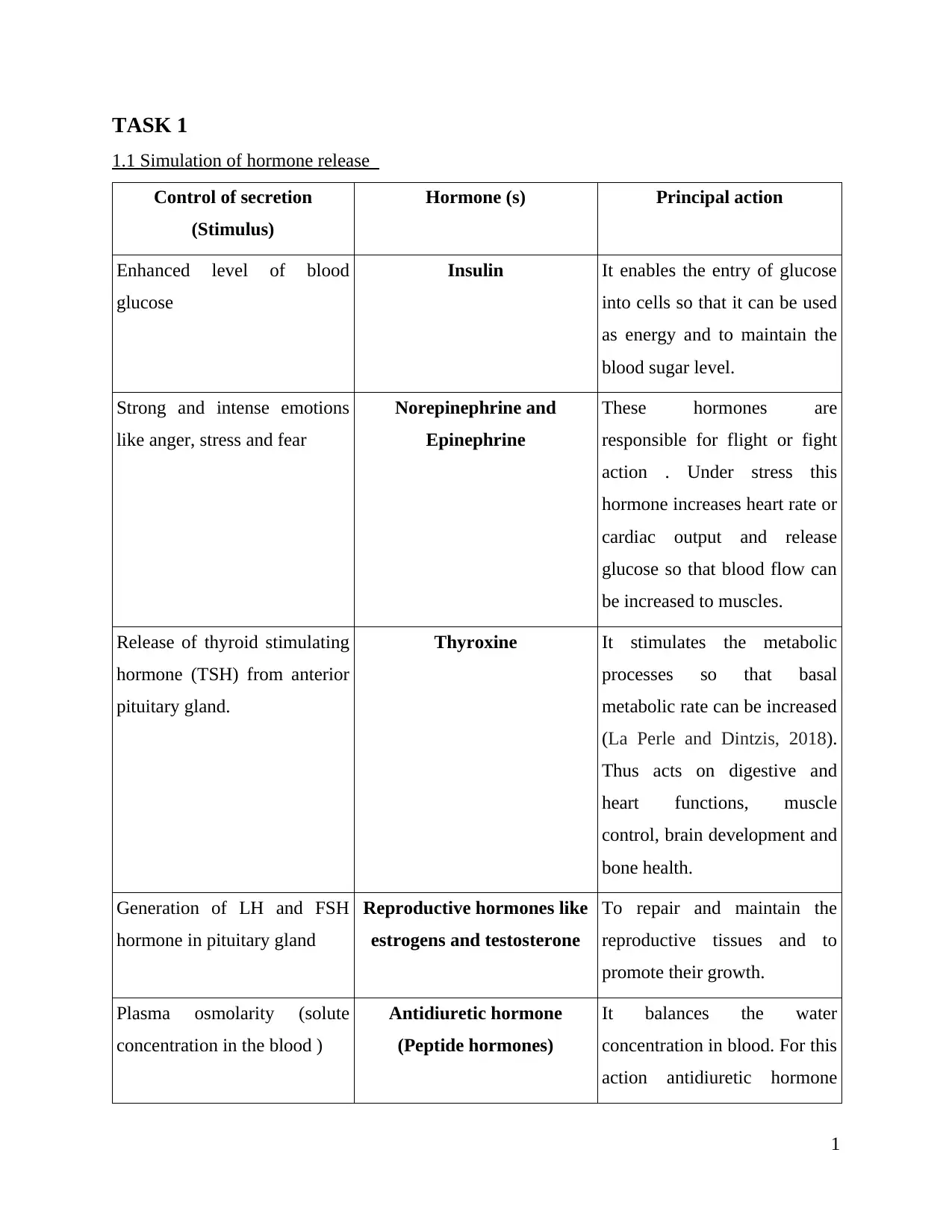
TASK 1
1.1 Simulation of hormone release
Control of secretion
(Stimulus)
Hormone (s) Principal action
Enhanced level of blood
glucose
Insulin It enables the entry of glucose
into cells so that it can be used
as energy and to maintain the
blood sugar level.
Strong and intense emotions
like anger, stress and fear
Norepinephrine and
Epinephrine
These hormones are
responsible for flight or fight
action . Under stress this
hormone increases heart rate or
cardiac output and release
glucose so that blood flow can
be increased to muscles.
Release of thyroid stimulating
hormone (TSH) from anterior
pituitary gland.
Thyroxine It stimulates the metabolic
processes so that basal
metabolic rate can be increased
(La Perle and Dintzis, 2018).
Thus acts on digestive and
heart functions, muscle
control, brain development and
bone health.
Generation of LH and FSH
hormone in pituitary gland
Reproductive hormones like
estrogens and testosterone
To repair and maintain the
reproductive tissues and to
promote their growth.
Plasma osmolarity (solute
concentration in the blood )
Antidiuretic hormone
(Peptide hormones)
It balances the water
concentration in blood. For this
action antidiuretic hormone
1
1.1 Simulation of hormone release
Control of secretion
(Stimulus)
Hormone (s) Principal action
Enhanced level of blood
glucose
Insulin It enables the entry of glucose
into cells so that it can be used
as energy and to maintain the
blood sugar level.
Strong and intense emotions
like anger, stress and fear
Norepinephrine and
Epinephrine
These hormones are
responsible for flight or fight
action . Under stress this
hormone increases heart rate or
cardiac output and release
glucose so that blood flow can
be increased to muscles.
Release of thyroid stimulating
hormone (TSH) from anterior
pituitary gland.
Thyroxine It stimulates the metabolic
processes so that basal
metabolic rate can be increased
(La Perle and Dintzis, 2018).
Thus acts on digestive and
heart functions, muscle
control, brain development and
bone health.
Generation of LH and FSH
hormone in pituitary gland
Reproductive hormones like
estrogens and testosterone
To repair and maintain the
reproductive tissues and to
promote their growth.
Plasma osmolarity (solute
concentration in the blood )
Antidiuretic hormone
(Peptide hormones)
It balances the water
concentration in blood. For this
action antidiuretic hormone
1
⊘ This is a preview!⊘
Do you want full access?
Subscribe today to unlock all pages.

Trusted by 1+ million students worldwide
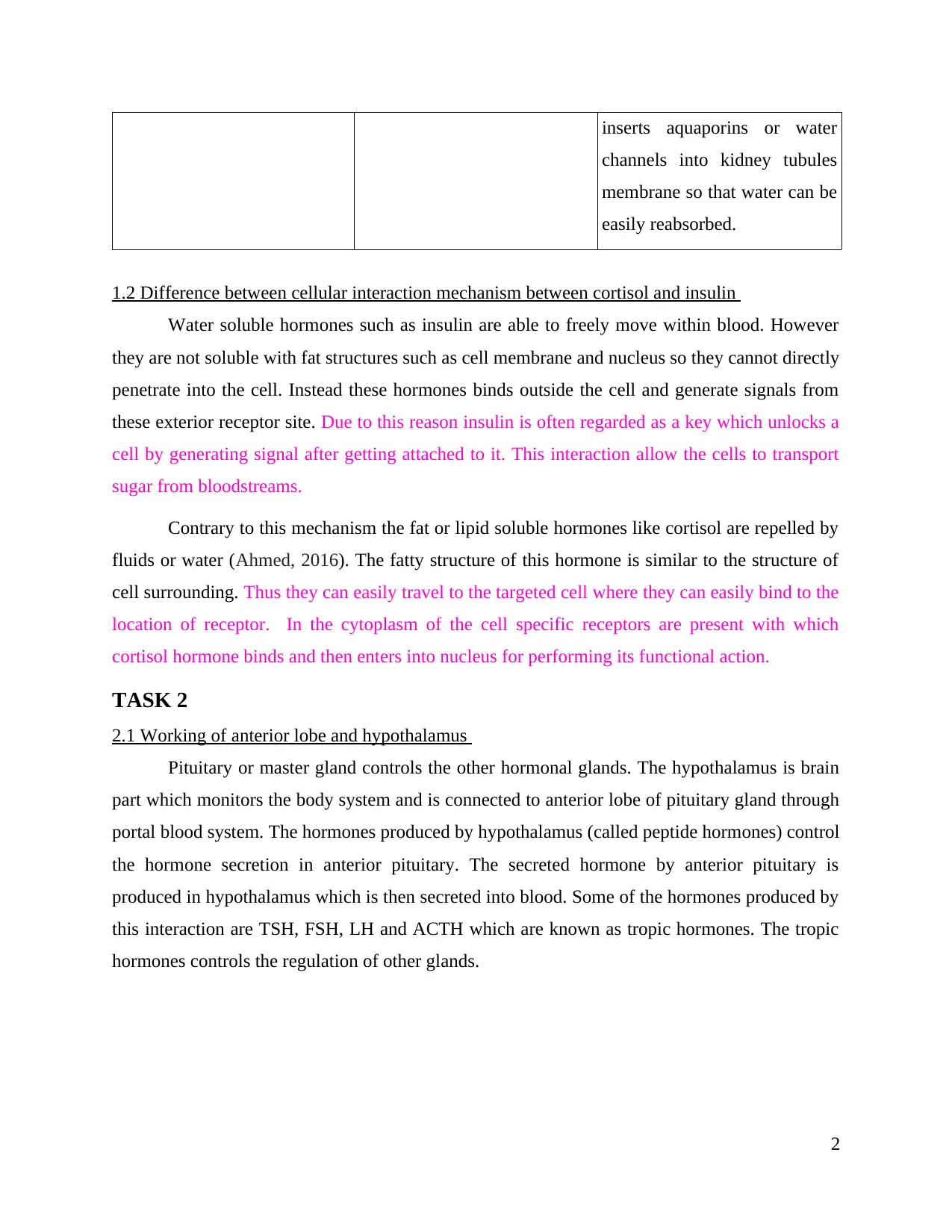
inserts aquaporins or water
channels into kidney tubules
membrane so that water can be
easily reabsorbed.
1.2 Difference between cellular interaction mechanism between cortisol and insulin
Water soluble hormones such as insulin are able to freely move within blood. However
they are not soluble with fat structures such as cell membrane and nucleus so they cannot directly
penetrate into the cell. Instead these hormones binds outside the cell and generate signals from
these exterior receptor site. Due to this reason insulin is often regarded as a key which unlocks a
cell by generating signal after getting attached to it. This interaction allow the cells to transport
sugar from bloodstreams.
Contrary to this mechanism the fat or lipid soluble hormones like cortisol are repelled by
fluids or water (Ahmed, 2016). The fatty structure of this hormone is similar to the structure of
cell surrounding. Thus they can easily travel to the targeted cell where they can easily bind to the
location of receptor. In the cytoplasm of the cell specific receptors are present with which
cortisol hormone binds and then enters into nucleus for performing its functional action.
TASK 2
2.1 Working of anterior lobe and hypothalamus
Pituitary or master gland controls the other hormonal glands. The hypothalamus is brain
part which monitors the body system and is connected to anterior lobe of pituitary gland through
portal blood system. The hormones produced by hypothalamus (called peptide hormones) control
the hormone secretion in anterior pituitary. The secreted hormone by anterior pituitary is
produced in hypothalamus which is then secreted into blood. Some of the hormones produced by
this interaction are TSH, FSH, LH and ACTH which are known as tropic hormones. The tropic
hormones controls the regulation of other glands.
2
channels into kidney tubules
membrane so that water can be
easily reabsorbed.
1.2 Difference between cellular interaction mechanism between cortisol and insulin
Water soluble hormones such as insulin are able to freely move within blood. However
they are not soluble with fat structures such as cell membrane and nucleus so they cannot directly
penetrate into the cell. Instead these hormones binds outside the cell and generate signals from
these exterior receptor site. Due to this reason insulin is often regarded as a key which unlocks a
cell by generating signal after getting attached to it. This interaction allow the cells to transport
sugar from bloodstreams.
Contrary to this mechanism the fat or lipid soluble hormones like cortisol are repelled by
fluids or water (Ahmed, 2016). The fatty structure of this hormone is similar to the structure of
cell surrounding. Thus they can easily travel to the targeted cell where they can easily bind to the
location of receptor. In the cytoplasm of the cell specific receptors are present with which
cortisol hormone binds and then enters into nucleus for performing its functional action.
TASK 2
2.1 Working of anterior lobe and hypothalamus
Pituitary or master gland controls the other hormonal glands. The hypothalamus is brain
part which monitors the body system and is connected to anterior lobe of pituitary gland through
portal blood system. The hormones produced by hypothalamus (called peptide hormones) control
the hormone secretion in anterior pituitary. The secreted hormone by anterior pituitary is
produced in hypothalamus which is then secreted into blood. Some of the hormones produced by
this interaction are TSH, FSH, LH and ACTH which are known as tropic hormones. The tropic
hormones controls the regulation of other glands.
2
Paraphrase This Document
Need a fresh take? Get an instant paraphrase of this document with our AI Paraphraser
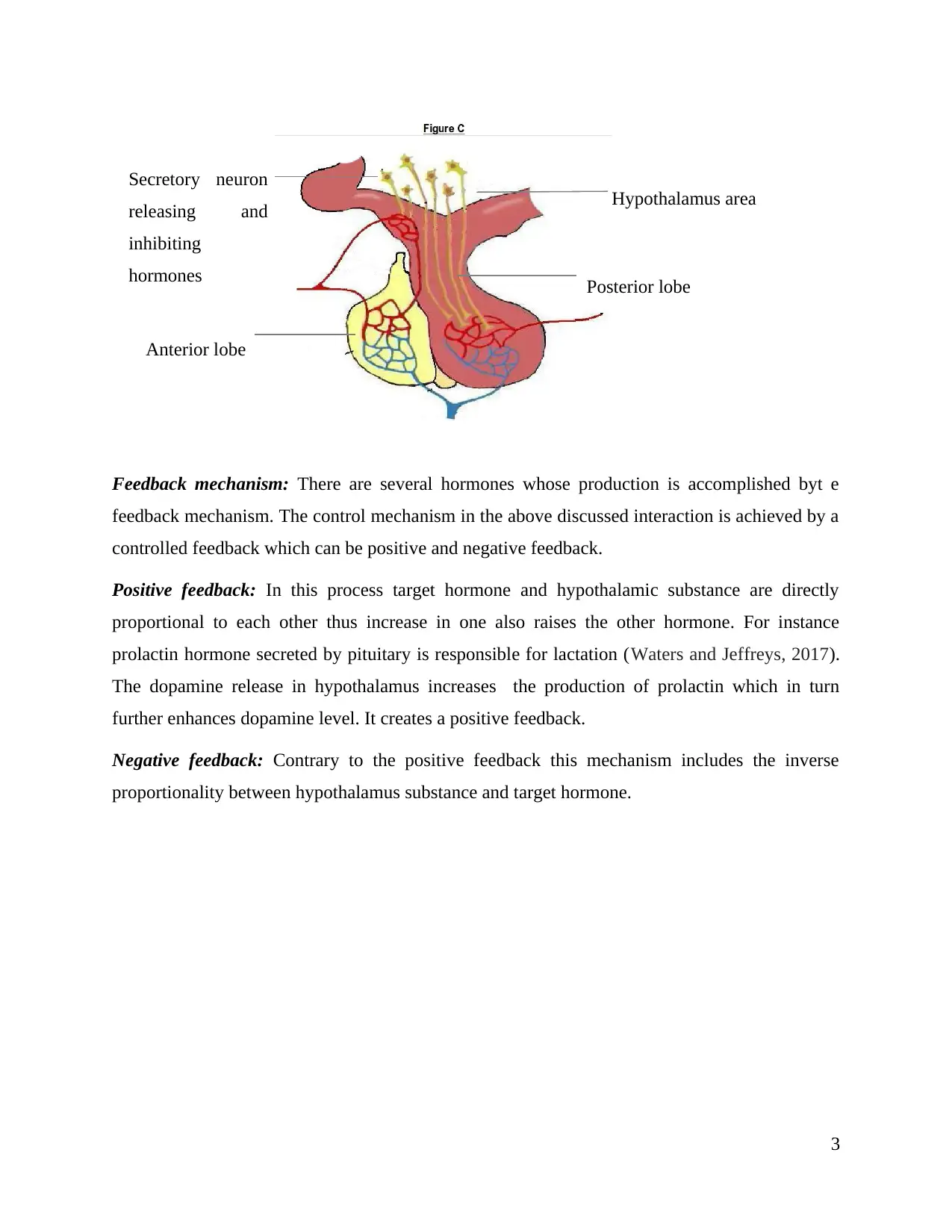
Feedback mechanism: There are several hormones whose production is accomplished byt e
feedback mechanism. The control mechanism in the above discussed interaction is achieved by a
controlled feedback which can be positive and negative feedback.
Positive feedback: In this process target hormone and hypothalamic substance are directly
proportional to each other thus increase in one also raises the other hormone. For instance
prolactin hormone secreted by pituitary is responsible for lactation (Waters and Jeffreys, 2017).
The dopamine release in hypothalamus increases the production of prolactin which in turn
further enhances dopamine level. It creates a positive feedback.
Negative feedback: Contrary to the positive feedback this mechanism includes the inverse
proportionality between hypothalamus substance and target hormone.
3
Anterior lobe
Hypothalamus area
Secretory neuron
releasing and
inhibiting
hormones Posterior lobe
feedback mechanism. The control mechanism in the above discussed interaction is achieved by a
controlled feedback which can be positive and negative feedback.
Positive feedback: In this process target hormone and hypothalamic substance are directly
proportional to each other thus increase in one also raises the other hormone. For instance
prolactin hormone secreted by pituitary is responsible for lactation (Waters and Jeffreys, 2017).
The dopamine release in hypothalamus increases the production of prolactin which in turn
further enhances dopamine level. It creates a positive feedback.
Negative feedback: Contrary to the positive feedback this mechanism includes the inverse
proportionality between hypothalamus substance and target hormone.
3
Anterior lobe
Hypothalamus area
Secretory neuron
releasing and
inhibiting
hormones Posterior lobe
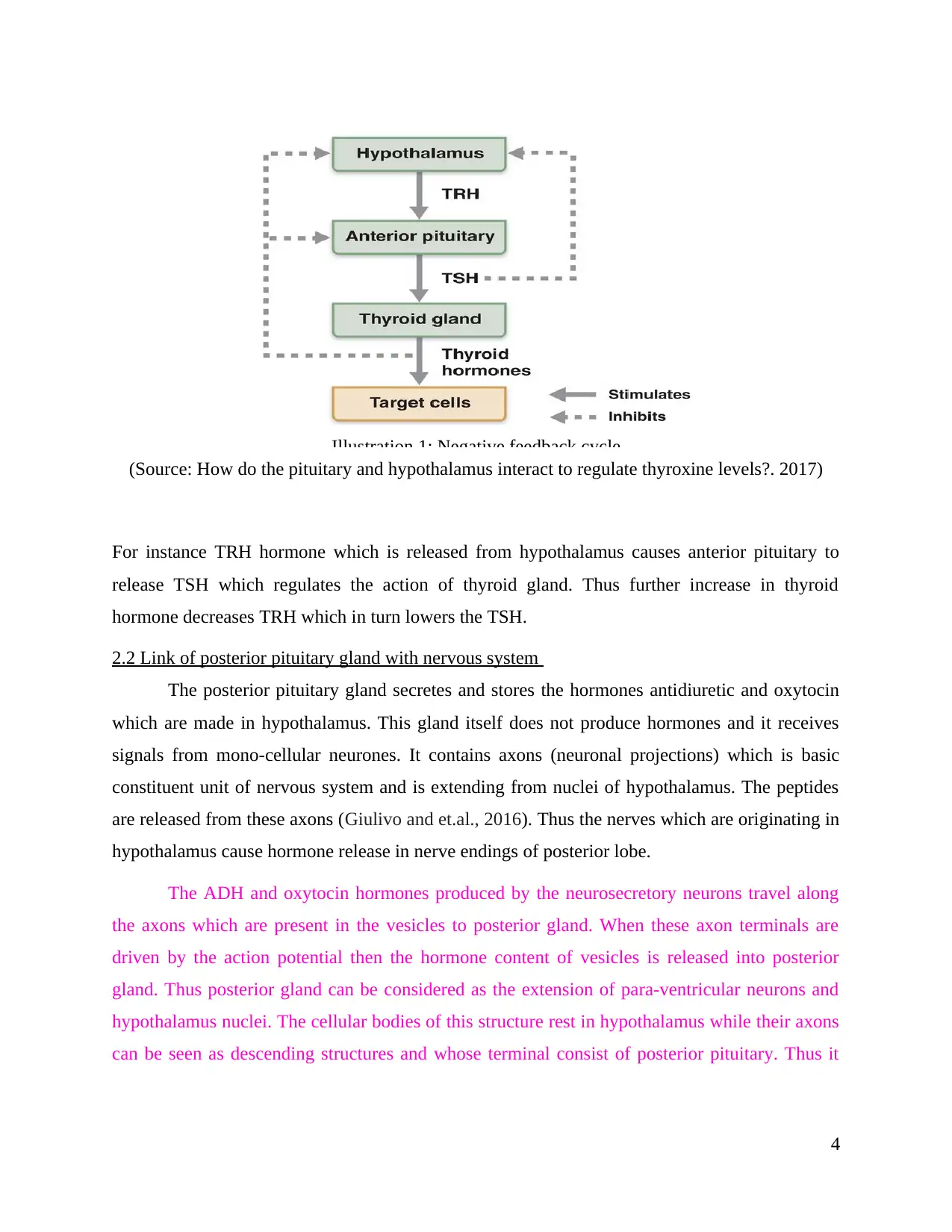
(Source: How do the pituitary and hypothalamus interact to regulate thyroxine levels?. 2017)
For instance TRH hormone which is released from hypothalamus causes anterior pituitary to
release TSH which regulates the action of thyroid gland. Thus further increase in thyroid
hormone decreases TRH which in turn lowers the TSH.
2.2 Link of posterior pituitary gland with nervous system
The posterior pituitary gland secretes and stores the hormones antidiuretic and oxytocin
which are made in hypothalamus. This gland itself does not produce hormones and it receives
signals from mono-cellular neurones. It contains axons (neuronal projections) which is basic
constituent unit of nervous system and is extending from nuclei of hypothalamus. The peptides
are released from these axons (Giulivo and et.al., 2016). Thus the nerves which are originating in
hypothalamus cause hormone release in nerve endings of posterior lobe.
The ADH and oxytocin hormones produced by the neurosecretory neurons travel along
the axons which are present in the vesicles to posterior gland. When these axon terminals are
driven by the action potential then the hormone content of vesicles is released into posterior
gland. Thus posterior gland can be considered as the extension of para-ventricular neurons and
hypothalamus nuclei. The cellular bodies of this structure rest in hypothalamus while their axons
can be seen as descending structures and whose terminal consist of posterior pituitary. Thus it
4
Illustration 1: Negative feedback cycle
For instance TRH hormone which is released from hypothalamus causes anterior pituitary to
release TSH which regulates the action of thyroid gland. Thus further increase in thyroid
hormone decreases TRH which in turn lowers the TSH.
2.2 Link of posterior pituitary gland with nervous system
The posterior pituitary gland secretes and stores the hormones antidiuretic and oxytocin
which are made in hypothalamus. This gland itself does not produce hormones and it receives
signals from mono-cellular neurones. It contains axons (neuronal projections) which is basic
constituent unit of nervous system and is extending from nuclei of hypothalamus. The peptides
are released from these axons (Giulivo and et.al., 2016). Thus the nerves which are originating in
hypothalamus cause hormone release in nerve endings of posterior lobe.
The ADH and oxytocin hormones produced by the neurosecretory neurons travel along
the axons which are present in the vesicles to posterior gland. When these axon terminals are
driven by the action potential then the hormone content of vesicles is released into posterior
gland. Thus posterior gland can be considered as the extension of para-ventricular neurons and
hypothalamus nuclei. The cellular bodies of this structure rest in hypothalamus while their axons
can be seen as descending structures and whose terminal consist of posterior pituitary. Thus it
4
Illustration 1: Negative feedback cycle
⊘ This is a preview!⊘
Do you want full access?
Subscribe today to unlock all pages.

Trusted by 1+ million students worldwide
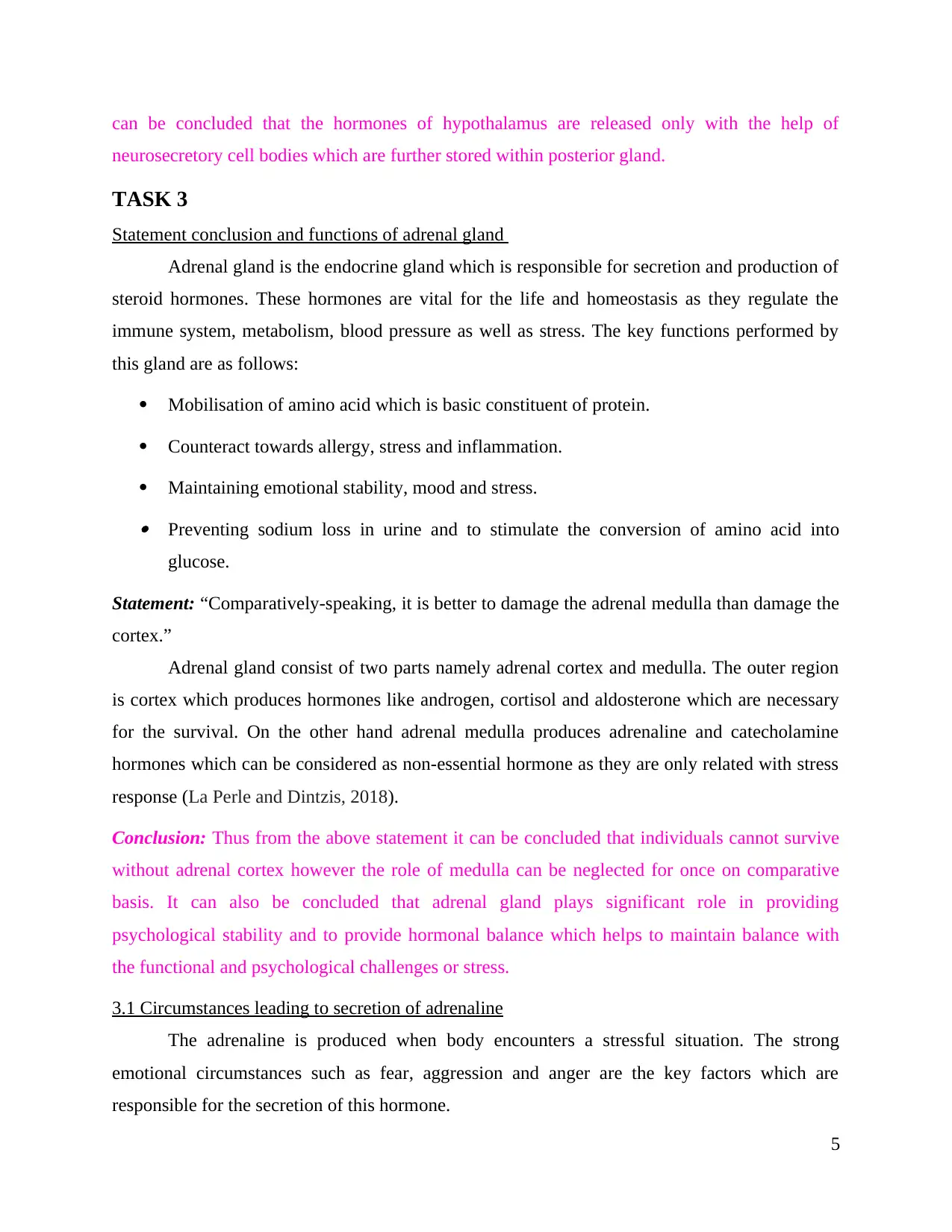
can be concluded that the hormones of hypothalamus are released only with the help of
neurosecretory cell bodies which are further stored within posterior gland.
TASK 3
Statement conclusion and functions of adrenal gland
Adrenal gland is the endocrine gland which is responsible for secretion and production of
steroid hormones. These hormones are vital for the life and homeostasis as they regulate the
immune system, metabolism, blood pressure as well as stress. The key functions performed by
this gland are as follows:
Mobilisation of amino acid which is basic constituent of protein.
Counteract towards allergy, stress and inflammation.
Maintaining emotional stability, mood and stress. Preventing sodium loss in urine and to stimulate the conversion of amino acid into
glucose.
Statement: “Comparatively-speaking, it is better to damage the adrenal medulla than damage the
cortex.”
Adrenal gland consist of two parts namely adrenal cortex and medulla. The outer region
is cortex which produces hormones like androgen, cortisol and aldosterone which are necessary
for the survival. On the other hand adrenal medulla produces adrenaline and catecholamine
hormones which can be considered as non-essential hormone as they are only related with stress
response (La Perle and Dintzis, 2018).
Conclusion: Thus from the above statement it can be concluded that individuals cannot survive
without adrenal cortex however the role of medulla can be neglected for once on comparative
basis. It can also be concluded that adrenal gland plays significant role in providing
psychological stability and to provide hormonal balance which helps to maintain balance with
the functional and psychological challenges or stress.
3.1 Circumstances leading to secretion of adrenaline
The adrenaline is produced when body encounters a stressful situation. The strong
emotional circumstances such as fear, aggression and anger are the key factors which are
responsible for the secretion of this hormone.
5
neurosecretory cell bodies which are further stored within posterior gland.
TASK 3
Statement conclusion and functions of adrenal gland
Adrenal gland is the endocrine gland which is responsible for secretion and production of
steroid hormones. These hormones are vital for the life and homeostasis as they regulate the
immune system, metabolism, blood pressure as well as stress. The key functions performed by
this gland are as follows:
Mobilisation of amino acid which is basic constituent of protein.
Counteract towards allergy, stress and inflammation.
Maintaining emotional stability, mood and stress. Preventing sodium loss in urine and to stimulate the conversion of amino acid into
glucose.
Statement: “Comparatively-speaking, it is better to damage the adrenal medulla than damage the
cortex.”
Adrenal gland consist of two parts namely adrenal cortex and medulla. The outer region
is cortex which produces hormones like androgen, cortisol and aldosterone which are necessary
for the survival. On the other hand adrenal medulla produces adrenaline and catecholamine
hormones which can be considered as non-essential hormone as they are only related with stress
response (La Perle and Dintzis, 2018).
Conclusion: Thus from the above statement it can be concluded that individuals cannot survive
without adrenal cortex however the role of medulla can be neglected for once on comparative
basis. It can also be concluded that adrenal gland plays significant role in providing
psychological stability and to provide hormonal balance which helps to maintain balance with
the functional and psychological challenges or stress.
3.1 Circumstances leading to secretion of adrenaline
The adrenaline is produced when body encounters a stressful situation. The strong
emotional circumstances such as fear, aggression and anger are the key factors which are
responsible for the secretion of this hormone.
5
Paraphrase This Document
Need a fresh take? Get an instant paraphrase of this document with our AI Paraphraser
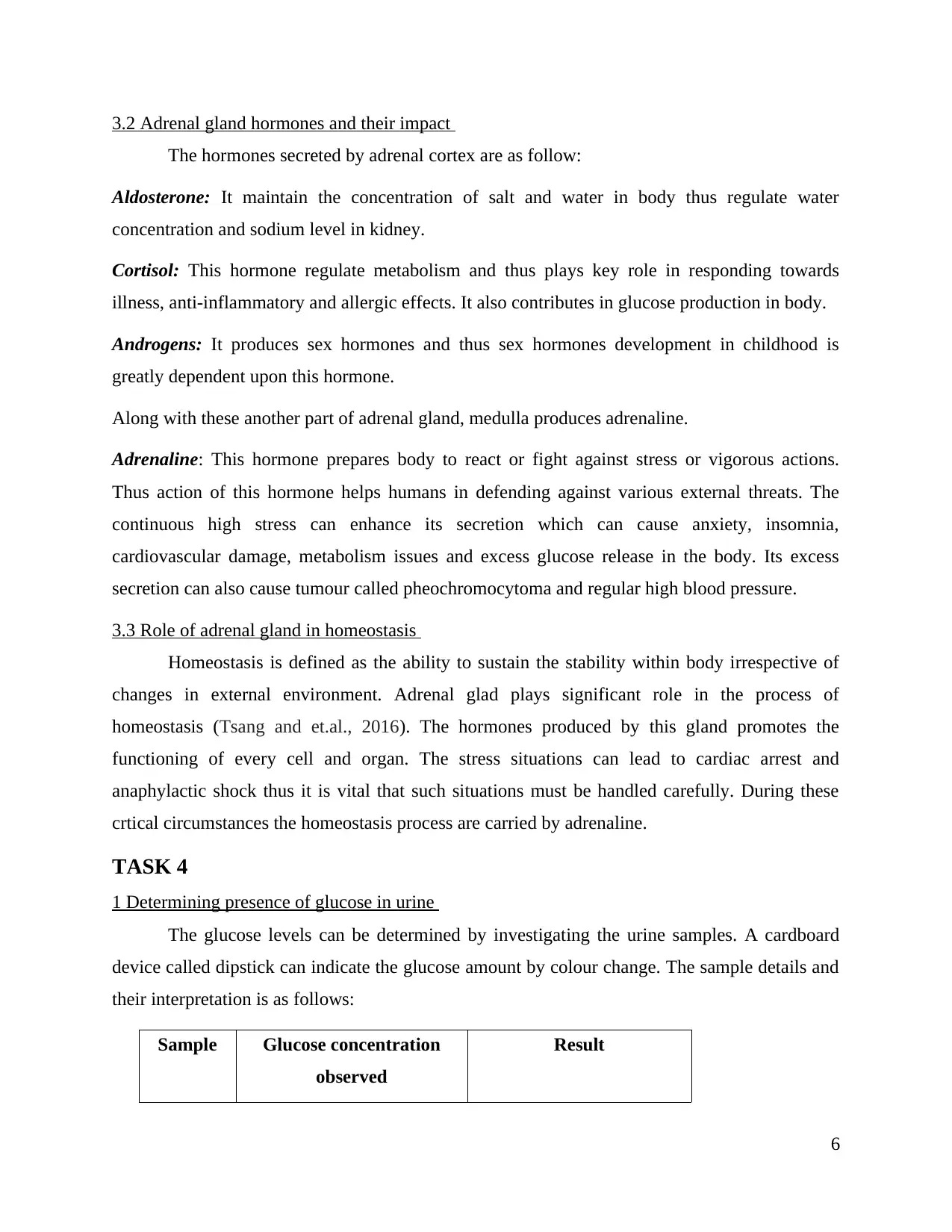
3.2 Adrenal gland hormones and their impact
The hormones secreted by adrenal cortex are as follow:
Aldosterone: It maintain the concentration of salt and water in body thus regulate water
concentration and sodium level in kidney.
Cortisol: This hormone regulate metabolism and thus plays key role in responding towards
illness, anti-inflammatory and allergic effects. It also contributes in glucose production in body.
Androgens: It produces sex hormones and thus sex hormones development in childhood is
greatly dependent upon this hormone.
Along with these another part of adrenal gland, medulla produces adrenaline.
Adrenaline: This hormone prepares body to react or fight against stress or vigorous actions.
Thus action of this hormone helps humans in defending against various external threats. The
continuous high stress can enhance its secretion which can cause anxiety, insomnia,
cardiovascular damage, metabolism issues and excess glucose release in the body. Its excess
secretion can also cause tumour called pheochromocytoma and regular high blood pressure.
3.3 Role of adrenal gland in homeostasis
Homeostasis is defined as the ability to sustain the stability within body irrespective of
changes in external environment. Adrenal glad plays significant role in the process of
homeostasis (Tsang and et.al., 2016). The hormones produced by this gland promotes the
functioning of every cell and organ. The stress situations can lead to cardiac arrest and
anaphylactic shock thus it is vital that such situations must be handled carefully. During these
crtical circumstances the homeostasis process are carried by adrenaline.
TASK 4
1 Determining presence of glucose in urine
The glucose levels can be determined by investigating the urine samples. A cardboard
device called dipstick can indicate the glucose amount by colour change. The sample details and
their interpretation is as follows:
Sample Glucose concentration
observed
Result
6
The hormones secreted by adrenal cortex are as follow:
Aldosterone: It maintain the concentration of salt and water in body thus regulate water
concentration and sodium level in kidney.
Cortisol: This hormone regulate metabolism and thus plays key role in responding towards
illness, anti-inflammatory and allergic effects. It also contributes in glucose production in body.
Androgens: It produces sex hormones and thus sex hormones development in childhood is
greatly dependent upon this hormone.
Along with these another part of adrenal gland, medulla produces adrenaline.
Adrenaline: This hormone prepares body to react or fight against stress or vigorous actions.
Thus action of this hormone helps humans in defending against various external threats. The
continuous high stress can enhance its secretion which can cause anxiety, insomnia,
cardiovascular damage, metabolism issues and excess glucose release in the body. Its excess
secretion can also cause tumour called pheochromocytoma and regular high blood pressure.
3.3 Role of adrenal gland in homeostasis
Homeostasis is defined as the ability to sustain the stability within body irrespective of
changes in external environment. Adrenal glad plays significant role in the process of
homeostasis (Tsang and et.al., 2016). The hormones produced by this gland promotes the
functioning of every cell and organ. The stress situations can lead to cardiac arrest and
anaphylactic shock thus it is vital that such situations must be handled carefully. During these
crtical circumstances the homeostasis process are carried by adrenaline.
TASK 4
1 Determining presence of glucose in urine
The glucose levels can be determined by investigating the urine samples. A cardboard
device called dipstick can indicate the glucose amount by colour change. The sample details and
their interpretation is as follows:
Sample Glucose concentration
observed
Result
6
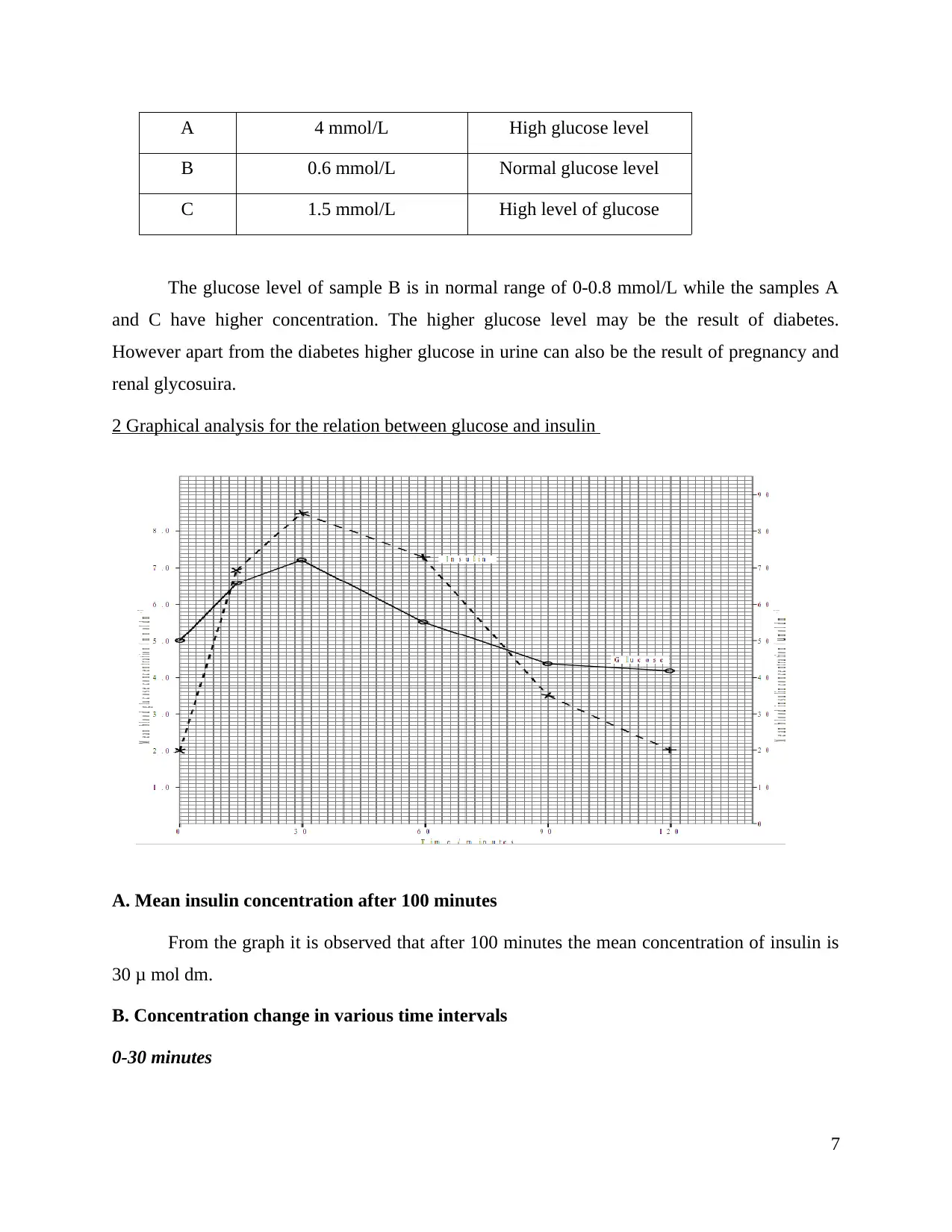
A 4 mmol/L High glucose level
B 0.6 mmol/L Normal glucose level
C 1.5 mmol/L High level of glucose
The glucose level of sample B is in normal range of 0-0.8 mmol/L while the samples A
and C have higher concentration. The higher glucose level may be the result of diabetes.
However apart from the diabetes higher glucose in urine can also be the result of pregnancy and
renal glycosuira.
2 Graphical analysis for the relation between glucose and insulin
A. Mean insulin concentration after 100 minutes
From the graph it is observed that after 100 minutes the mean concentration of insulin is
30 μ mol dm.
B. Concentration change in various time intervals
0-30 minutes
7
B 0.6 mmol/L Normal glucose level
C 1.5 mmol/L High level of glucose
The glucose level of sample B is in normal range of 0-0.8 mmol/L while the samples A
and C have higher concentration. The higher glucose level may be the result of diabetes.
However apart from the diabetes higher glucose in urine can also be the result of pregnancy and
renal glycosuira.
2 Graphical analysis for the relation between glucose and insulin
A. Mean insulin concentration after 100 minutes
From the graph it is observed that after 100 minutes the mean concentration of insulin is
30 μ mol dm.
B. Concentration change in various time intervals
0-30 minutes
7
⊘ This is a preview!⊘
Do you want full access?
Subscribe today to unlock all pages.

Trusted by 1+ million students worldwide
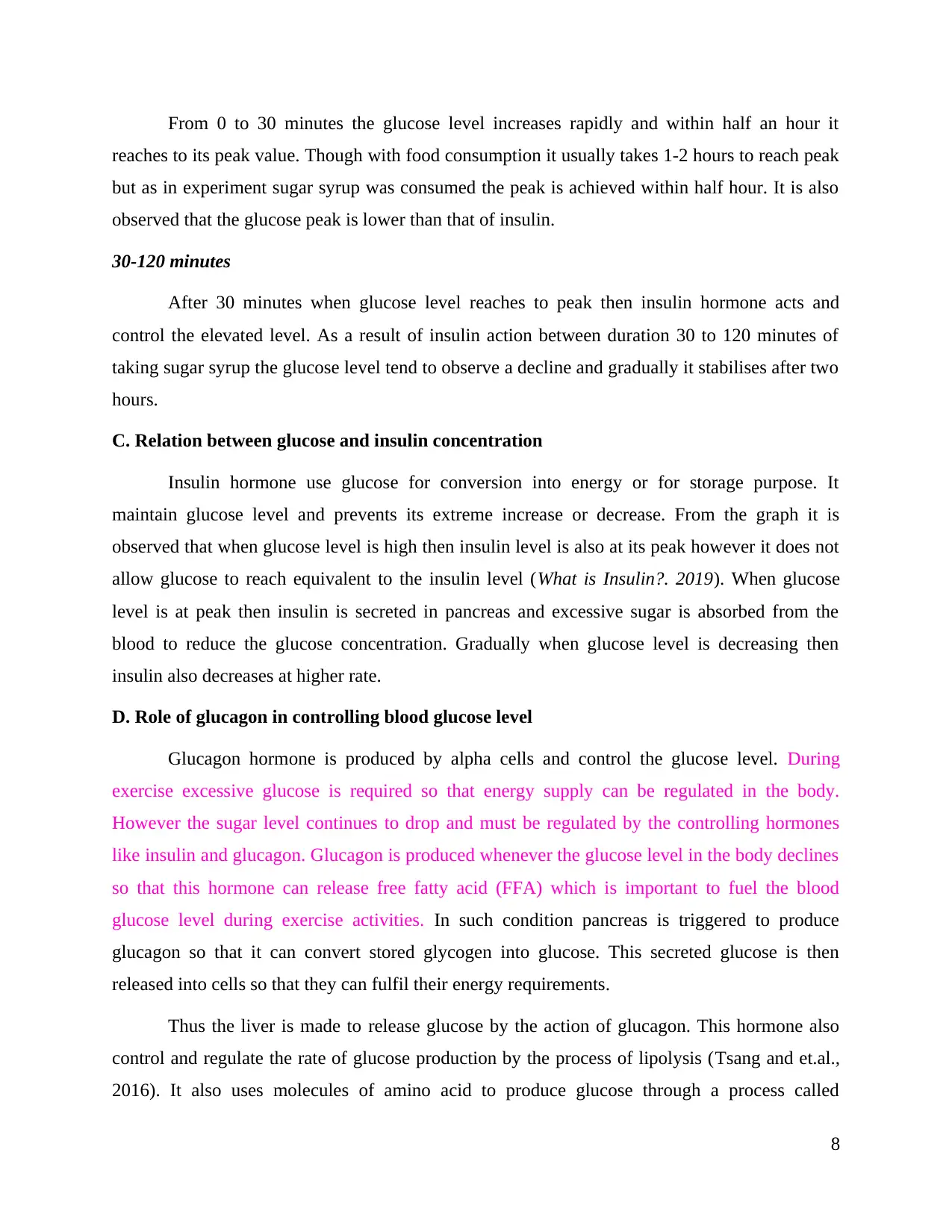
From 0 to 30 minutes the glucose level increases rapidly and within half an hour it
reaches to its peak value. Though with food consumption it usually takes 1-2 hours to reach peak
but as in experiment sugar syrup was consumed the peak is achieved within half hour. It is also
observed that the glucose peak is lower than that of insulin.
30-120 minutes
After 30 minutes when glucose level reaches to peak then insulin hormone acts and
control the elevated level. As a result of insulin action between duration 30 to 120 minutes of
taking sugar syrup the glucose level tend to observe a decline and gradually it stabilises after two
hours.
C. Relation between glucose and insulin concentration
Insulin hormone use glucose for conversion into energy or for storage purpose. It
maintain glucose level and prevents its extreme increase or decrease. From the graph it is
observed that when glucose level is high then insulin level is also at its peak however it does not
allow glucose to reach equivalent to the insulin level (What is Insulin?. 2019). When glucose
level is at peak then insulin is secreted in pancreas and excessive sugar is absorbed from the
blood to reduce the glucose concentration. Gradually when glucose level is decreasing then
insulin also decreases at higher rate.
D. Role of glucagon in controlling blood glucose level
Glucagon hormone is produced by alpha cells and control the glucose level. During
exercise excessive glucose is required so that energy supply can be regulated in the body.
However the sugar level continues to drop and must be regulated by the controlling hormones
like insulin and glucagon. Glucagon is produced whenever the glucose level in the body declines
so that this hormone can release free fatty acid (FFA) which is important to fuel the blood
glucose level during exercise activities. In such condition pancreas is triggered to produce
glucagon so that it can convert stored glycogen into glucose. This secreted glucose is then
released into cells so that they can fulfil their energy requirements.
Thus the liver is made to release glucose by the action of glucagon. This hormone also
control and regulate the rate of glucose production by the process of lipolysis (Tsang and et.al.,
2016). It also uses molecules of amino acid to produce glucose through a process called
8
reaches to its peak value. Though with food consumption it usually takes 1-2 hours to reach peak
but as in experiment sugar syrup was consumed the peak is achieved within half hour. It is also
observed that the glucose peak is lower than that of insulin.
30-120 minutes
After 30 minutes when glucose level reaches to peak then insulin hormone acts and
control the elevated level. As a result of insulin action between duration 30 to 120 minutes of
taking sugar syrup the glucose level tend to observe a decline and gradually it stabilises after two
hours.
C. Relation between glucose and insulin concentration
Insulin hormone use glucose for conversion into energy or for storage purpose. It
maintain glucose level and prevents its extreme increase or decrease. From the graph it is
observed that when glucose level is high then insulin level is also at its peak however it does not
allow glucose to reach equivalent to the insulin level (What is Insulin?. 2019). When glucose
level is at peak then insulin is secreted in pancreas and excessive sugar is absorbed from the
blood to reduce the glucose concentration. Gradually when glucose level is decreasing then
insulin also decreases at higher rate.
D. Role of glucagon in controlling blood glucose level
Glucagon hormone is produced by alpha cells and control the glucose level. During
exercise excessive glucose is required so that energy supply can be regulated in the body.
However the sugar level continues to drop and must be regulated by the controlling hormones
like insulin and glucagon. Glucagon is produced whenever the glucose level in the body declines
so that this hormone can release free fatty acid (FFA) which is important to fuel the blood
glucose level during exercise activities. In such condition pancreas is triggered to produce
glucagon so that it can convert stored glycogen into glucose. This secreted glucose is then
released into cells so that they can fulfil their energy requirements.
Thus the liver is made to release glucose by the action of glucagon. This hormone also
control and regulate the rate of glucose production by the process of lipolysis (Tsang and et.al.,
2016). It also uses molecules of amino acid to produce glucose through a process called
8
Paraphrase This Document
Need a fresh take? Get an instant paraphrase of this document with our AI Paraphraser
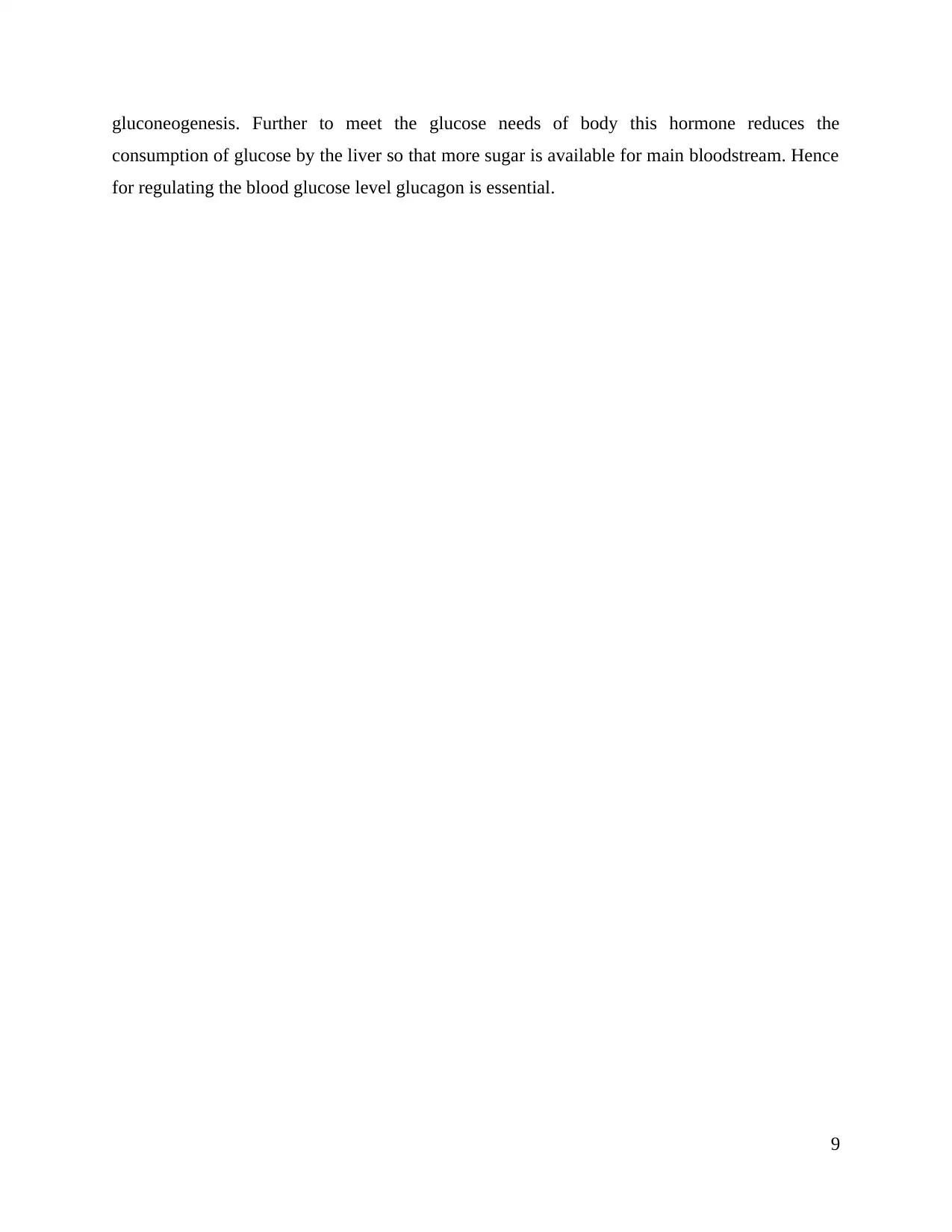
gluconeogenesis. Further to meet the glucose needs of body this hormone reduces the
consumption of glucose by the liver so that more sugar is available for main bloodstream. Hence
for regulating the blood glucose level glucagon is essential.
9
consumption of glucose by the liver so that more sugar is available for main bloodstream. Hence
for regulating the blood glucose level glucagon is essential.
9
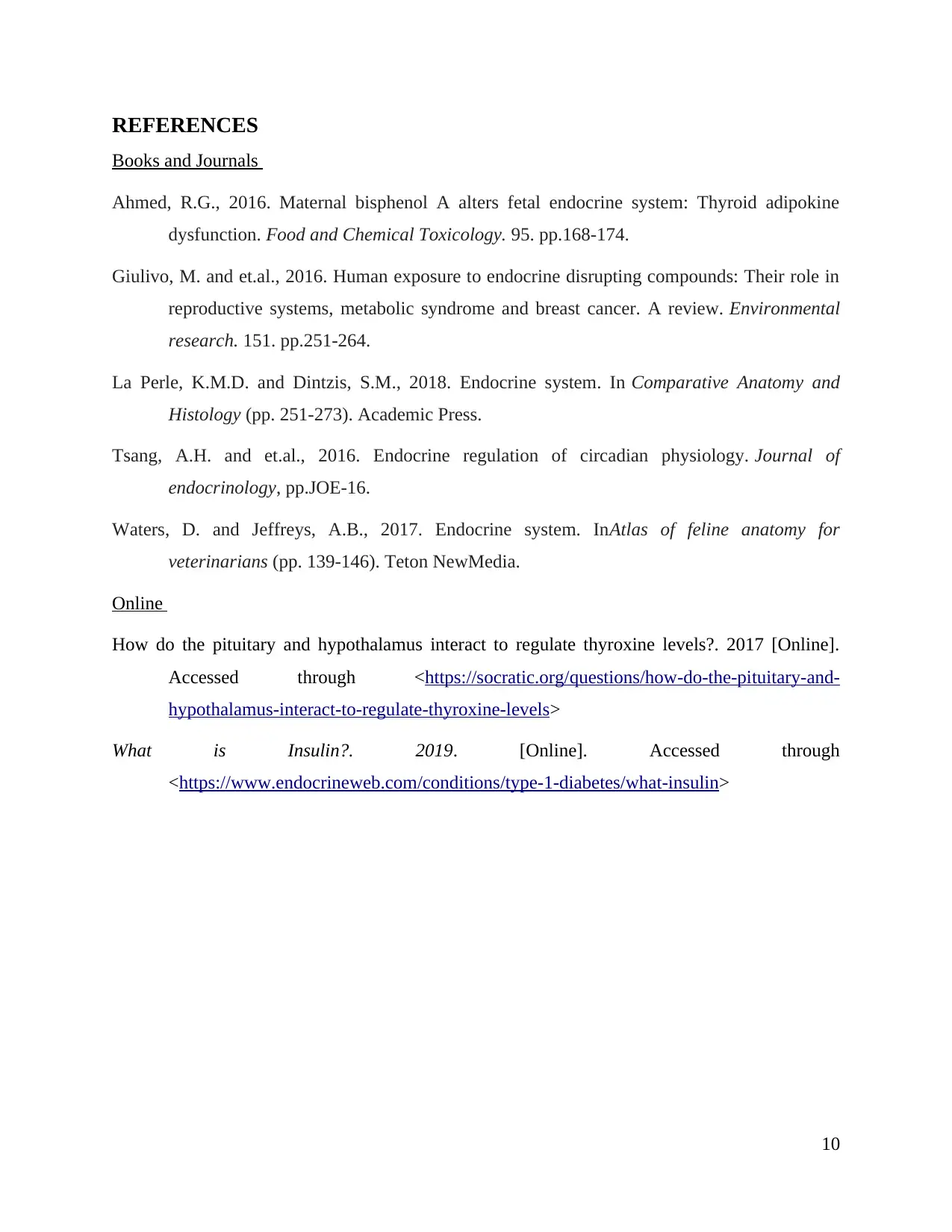
REFERENCES
Books and Journals
Ahmed, R.G., 2016. Maternal bisphenol A alters fetal endocrine system: Thyroid adipokine
dysfunction. Food and Chemical Toxicology. 95. pp.168-174.
Giulivo, M. and et.al., 2016. Human exposure to endocrine disrupting compounds: Their role in
reproductive systems, metabolic syndrome and breast cancer. A review. Environmental
research. 151. pp.251-264.
La Perle, K.M.D. and Dintzis, S.M., 2018. Endocrine system. In Comparative Anatomy and
Histology (pp. 251-273). Academic Press.
Tsang, A.H. and et.al., 2016. Endocrine regulation of circadian physiology. Journal of
endocrinology, pp.JOE-16.
Waters, D. and Jeffreys, A.B., 2017. Endocrine system. InAtlas of feline anatomy for
veterinarians (pp. 139-146). Teton NewMedia.
Online
How do the pituitary and hypothalamus interact to regulate thyroxine levels?. 2017 [Online].
Accessed through <https://socratic.org/questions/how-do-the-pituitary-and-
hypothalamus-interact-to-regulate-thyroxine-levels>
What is Insulin?. 2019. [Online]. Accessed through
<https://www.endocrineweb.com/conditions/type-1-diabetes/what-insulin>
10
Books and Journals
Ahmed, R.G., 2016. Maternal bisphenol A alters fetal endocrine system: Thyroid adipokine
dysfunction. Food and Chemical Toxicology. 95. pp.168-174.
Giulivo, M. and et.al., 2016. Human exposure to endocrine disrupting compounds: Their role in
reproductive systems, metabolic syndrome and breast cancer. A review. Environmental
research. 151. pp.251-264.
La Perle, K.M.D. and Dintzis, S.M., 2018. Endocrine system. In Comparative Anatomy and
Histology (pp. 251-273). Academic Press.
Tsang, A.H. and et.al., 2016. Endocrine regulation of circadian physiology. Journal of
endocrinology, pp.JOE-16.
Waters, D. and Jeffreys, A.B., 2017. Endocrine system. InAtlas of feline anatomy for
veterinarians (pp. 139-146). Teton NewMedia.
Online
How do the pituitary and hypothalamus interact to regulate thyroxine levels?. 2017 [Online].
Accessed through <https://socratic.org/questions/how-do-the-pituitary-and-
hypothalamus-interact-to-regulate-thyroxine-levels>
What is Insulin?. 2019. [Online]. Accessed through
<https://www.endocrineweb.com/conditions/type-1-diabetes/what-insulin>
10
⊘ This is a preview!⊘
Do you want full access?
Subscribe today to unlock all pages.

Trusted by 1+ million students worldwide
1 out of 12
Related Documents
Your All-in-One AI-Powered Toolkit for Academic Success.
+13062052269
info@desklib.com
Available 24*7 on WhatsApp / Email
![[object Object]](/_next/static/media/star-bottom.7253800d.svg)
Unlock your academic potential
Copyright © 2020–2025 A2Z Services. All Rights Reserved. Developed and managed by ZUCOL.




